 We hear mostly about the social networking sites where English is the predominant language, like Facebook, MySpace and Twitter. But what about those sites where the vast majority of users don’t speak or use English? We don’t hear about those very much.
We hear mostly about the social networking sites where English is the predominant language, like Facebook, MySpace and Twitter. But what about those sites where the vast majority of users don’t speak or use English? We don’t hear about those very much.
But that doesn’t mean they’re not out there. And many are doing extremely well. One of them is even big enough to rival Facebook in sheer user count.
The social networking sites we list below have reached an overwhelming popularity outside of the (native) English-speaking population, often being local hits in one or just a few countries and a specific language.
Skyrock, popular in France
![]() Although Skyrock, a social network aimed at people under 25, supports other languages than French, that’s where its roots are and its main popularity are in French-speaking countries (especially France itself). It’s the fifth most popular website in France according to Alexa. In June 2008 Comscore ranked it as the seventh most popular social network in the world with 21 million monthly visitors. Skyrock got its start as a blogging service in 2002 (at the time it was called Skyblog.com), but in 2007 Skyrock.com was launched as a real social network site.
Although Skyrock, a social network aimed at people under 25, supports other languages than French, that’s where its roots are and its main popularity are in French-speaking countries (especially France itself). It’s the fifth most popular website in France according to Alexa. In June 2008 Comscore ranked it as the seventh most popular social network in the world with 21 million monthly visitors. Skyrock got its start as a blogging service in 2002 (at the time it was called Skyblog.com), but in 2007 Skyrock.com was launched as a real social network site.
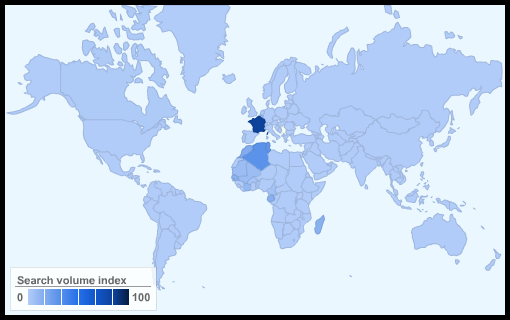
Above: Skyrock’s regional popularity based on Google search data.
Mixi, popular in Japan
![]() Mixi is a Japanese invite-only social networking service started in 2004. In May 2008, Mixi had 80% of the social networking market in Japan. The service now has more than 24 million users and is the eighth most popular website in Japan according to Alexa. It’s difficult to join Mixi if you don’t live in Japan because you need to provide a Japanese cell phone email address to register.
Mixi is a Japanese invite-only social networking service started in 2004. In May 2008, Mixi had 80% of the social networking market in Japan. The service now has more than 24 million users and is the eighth most popular website in Japan according to Alexa. It’s difficult to join Mixi if you don’t live in Japan because you need to provide a Japanese cell phone email address to register.
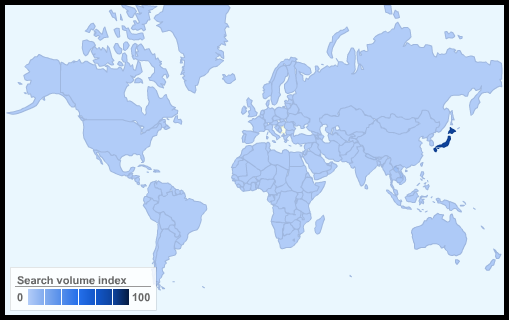
Above: Mixi’s regional popularity based on Google search data.
Tuenti, popular in Spain
![]() Tuenti is a Spanish social networking site launched in 2006, sometimes called the “Spanish Facebook”. It’s targeted specifically at a Spanish audience and is an invite-only service. “Tuenti” was the fourth fastest-rising search term in the world according to Google’s 2008 Zeitgeist report. According to Alexa it’s currently the sixth most popular site in Spain and Comscore says the site had 5.6 million visitors in December 2008.
Tuenti is a Spanish social networking site launched in 2006, sometimes called the “Spanish Facebook”. It’s targeted specifically at a Spanish audience and is an invite-only service. “Tuenti” was the fourth fastest-rising search term in the world according to Google’s 2008 Zeitgeist report. According to Alexa it’s currently the sixth most popular site in Spain and Comscore says the site had 5.6 million visitors in December 2008.
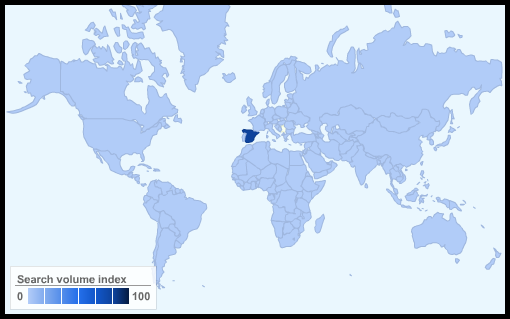
Above: Tuenti’s regional popularity based on Google search data.
Vkontakte, popular in Russia
![]() Vkontakte is essentially a Russian Facebook, emulating the latter to the extent that it’s often been accused of being a Facebook clone. Regardless of that, it has become the most popular social networking site in Russia, Ukraine and Belarus. It was launched in 2006 and as of August 2009, Vkontakte had more than 40 million users. It’s the second most popular website in Russia according to Alexa. Translated, “V Kontakte” means “In Touch”.
Vkontakte is essentially a Russian Facebook, emulating the latter to the extent that it’s often been accused of being a Facebook clone. Regardless of that, it has become the most popular social networking site in Russia, Ukraine and Belarus. It was launched in 2006 and as of August 2009, Vkontakte had more than 40 million users. It’s the second most popular website in Russia according to Alexa. Translated, “V Kontakte” means “In Touch”.
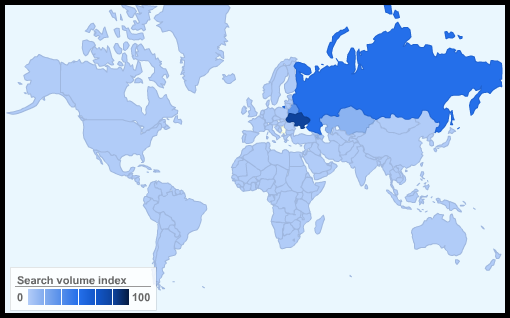
Above: Vkontakte’s regional popularity based on Google search data.
Orkut, popular in Brazil
 Orkut is Google’s social network, the one they launched in 2004. But when was the last time you heard any buzz about it in the US, or the UK, or any English-speaking country for that matter? Not for some time. However, there is one place where Orkut is huge; Brazil. Roughly half of Orkut’s entire user base comes from Brazil. Orkut is doing so well in Brazil that Google decided in 2008 that the service would be operated from Brazil (by Google Brazil). Orkut is the second most popular website in Brazil according to Alexa. It’s also doing quite well in India.
Orkut is Google’s social network, the one they launched in 2004. But when was the last time you heard any buzz about it in the US, or the UK, or any English-speaking country for that matter? Not for some time. However, there is one place where Orkut is huge; Brazil. Roughly half of Orkut’s entire user base comes from Brazil. Orkut is doing so well in Brazil that Google decided in 2008 that the service would be operated from Brazil (by Google Brazil). Orkut is the second most popular website in Brazil according to Alexa. It’s also doing quite well in India.
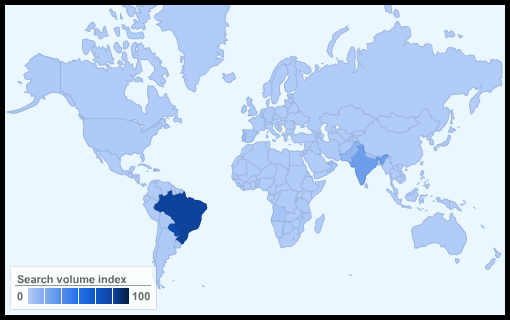
Above: Orkut’s regional popularity based on Google search data.
Qzone, popular in China
 Qzone, China’s largest social networking site, reportedly had more than 200 million users as of January 2009, rivaling Facebook for the title of the world’s largest social network. The website was launched in 2005 by Tencent, the company also behind QQ, China’s most popular instant messaging program.
Qzone, China’s largest social networking site, reportedly had more than 200 million users as of January 2009, rivaling Facebook for the title of the world’s largest social network. The website was launched in 2005 by Tencent, the company also behind QQ, China’s most popular instant messaging program.

Above: Qzone’s regional popularity based on Google search data.
Friendster, popular in the Philippines
![]() Launched in 2003 to instant stardom, these days Friendster may no longer be the world-leader it was back in 2003-2004, but it is still immensely popular in parts of Asia and especially in the Philippines. It’s the third most popular website in the Philippines, but it also ranks highly in Indonesia and Malaysia. More than 90% of Friendster’s traffic comes from Asia. According to Friendster, its service has more than 110 million members worldwide. Friendster has its head office in Australia.
Launched in 2003 to instant stardom, these days Friendster may no longer be the world-leader it was back in 2003-2004, but it is still immensely popular in parts of Asia and especially in the Philippines. It’s the third most popular website in the Philippines, but it also ranks highly in Indonesia and Malaysia. More than 90% of Friendster’s traffic comes from Asia. According to Friendster, its service has more than 110 million members worldwide. Friendster has its head office in Australia.

Above: Friendster’s regional popularity based on Google search data.
Hyves, popular in the Netherlands
![]() Hyves is a Dutch social networking site that was launched in 2004. In July 2008 the site had reached a user base of seven million, and five of those were Dutch. That’s the equivalent of one third of the population of the Netherlands. As of August 2009 the service has over nine million users and is the second most popular website in the Netherlands. The word Hyves refers to the English word Beehive. However, since the domain name hives.nl was already registered by someone else, they went with hyves.nl instead.
Hyves is a Dutch social networking site that was launched in 2004. In July 2008 the site had reached a user base of seven million, and five of those were Dutch. That’s the equivalent of one third of the population of the Netherlands. As of August 2009 the service has over nine million users and is the second most popular website in the Netherlands. The word Hyves refers to the English word Beehive. However, since the domain name hives.nl was already registered by someone else, they went with hyves.nl instead.
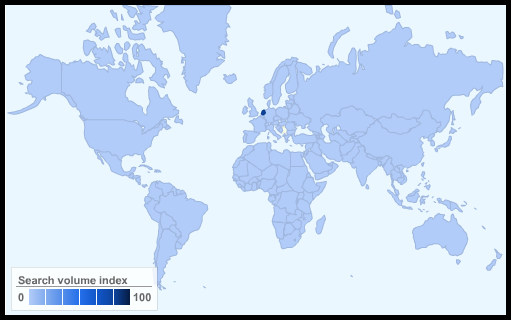
Above: Hyves’s regional popularity based on Google search data.
Cyworld, popular in South Korea
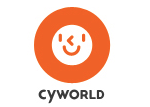 Cyworld is a South Korean social networking site. It’s the oldest of the sites we have listed in this article, launched all the way back in 1999. Versions of the site has later also been launched in the US, China, Japan, Taiwan and Vietnam. Reports show that as much as 90% of South Koreans in their twenties have a Cyworld account. It’s the ninth most popular website in South Korea according to Alexa. The “cy” in Cyworld is a play on words, referring to both “cyber” and the Korean word for “relationship”.
Cyworld is a South Korean social networking site. It’s the oldest of the sites we have listed in this article, launched all the way back in 1999. Versions of the site has later also been launched in the US, China, Japan, Taiwan and Vietnam. Reports show that as much as 90% of South Koreans in their twenties have a Cyworld account. It’s the ninth most popular website in South Korea according to Alexa. The “cy” in Cyworld is a play on words, referring to both “cyber” and the Korean word for “relationship”.
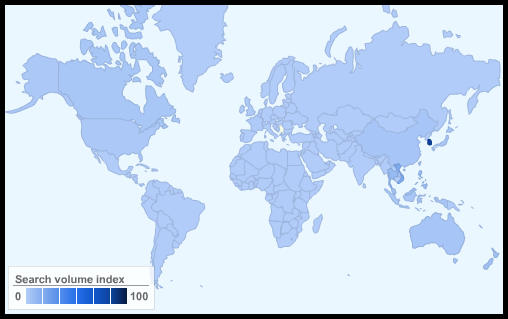
Above: Cyworld’s regional popularity based on Google search data.
We hope you enjoyed this look outside the English-speaking sphere of the Web. 🙂



























